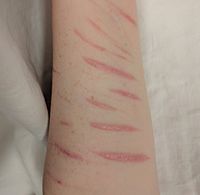
Photo from wikipedia
BACKGROUND Identifying the risk factors of suicide attempts(SA) in adolescents with mood disorders(MD) who engage in non-suicidal self-injury(NSSI) is of great significance for suicide prevention. The aim of the present… Click to show full abstract
BACKGROUND Identifying the risk factors of suicide attempts(SA) in adolescents with mood disorders(MD) who engage in non-suicidal self-injury(NSSI) is of great significance for suicide prevention. The aim of the present study was to explore the psychological characteristics and risk factors of SA among MD adolescents engaged in NSSI. METHODS We recruited MD outpatients accompany with NSSI aged 12-18 years. SA, NSSI methods and function, suicidal ideation(SI), psychological distress(PD), self-esteem, stress mindset and perceived social support were assessed by valid scales. Classification and regression tree analysis (CART) was employed to explore the characteristics and risk factors of SA among MD adolescent with NSSI. RESULTS We included 658 participants in this study. Of 58.1% participants reported SA during the past 12 months. Compared with the adolescents without SA, the attempters used more different NSSI methods and reported more frequent NSSI. SA, SI, PD, self-esteem and amount of thinking time before engaging in self-injury were risk factors of SA among MD adolescents. Interactions between the four risk factors resulted in varying degrees of risk of SA. Compared to adolescents with the characteristics of low level of SI - little consideration before self-injury, adolescents who having multiple characteristics of the high level of SI -high level of PD - low self-esteem were associated with a 15.1-fold increased risk of SA(P<0.001), and those with the characteristics of high SI - deliberated before engaging in self-injury were associated with a 28.1-fold increased risk of attempted suicide(P<0.001). CONCLUSIONS Our findings identify multiple correlates for SA in MD adolescents accompany with NSSI, including SI, PD, self-esteem and deliberate time they thought before self-injury, which may contribute to the development of suicidal behaviors in an interactive manner.
Journal Title: Journal of affective disorders
Year Published: 2021
Link to full text (if available)
Share on Social Media: Sign Up to like & get
recommendations!